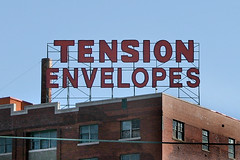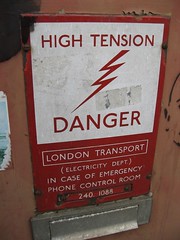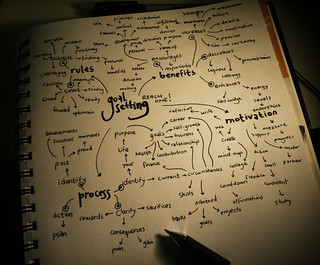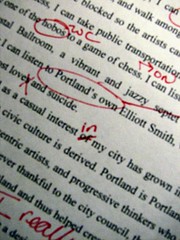When you see a building under construction, your eyes are naturally drawn not to the building, but to the latticework of metal encasing its facade. In writing, the same attention to certain words and phrases—in this case “head words”—creates the same effect.
 Sometimes we use phrases like “he thought” or “she knew” to reinforce the POV character’s connection with the thoughts in narration. But instead of drawing our readers’ attention to the character’s thoughts, too many of these phrases can draw attention to that scaffolding—the words that encase the character’s thoughts. Remember the example we used early on of watching a character looking out the window versus seeing the view ourselves?
Sometimes we use phrases like “he thought” or “she knew” to reinforce the POV character’s connection with the thoughts in narration. But instead of drawing our readers’ attention to the character’s thoughts, too many of these phrases can draw attention to that scaffolding—the words that encase the character’s thoughts. Remember the example we used early on of watching a character looking out the window versus seeing the view ourselves?
This passage from the otherwise excellent Scene & Structure by Jack Bickham exemplifies the thinking behind this problem:
Failure to use constructions that show viewpoint is quite common, and, we can be thankful easy to fix. . . .
Consider the following statements:
The cold wind blew harder.
A gunshot rang out.
It was terrifying.These are fine observations, but in none of them do we know where the viewpoint is. Ordinarily you should recast such statements to emphasize the viewpoint, thus:
She felt the cold wind blow harder.
He heard a gunshot ring out.
It was terrifying, she thought. Or:
Terror crept through her.(89)
I can’t say whether it’s just publishing trends or the version of deep POV that’s au courant, but today, publishing trends have moved far, far away from his “fixes” (other than the last one, of course). Today, such “scaffold fixes” smack of telling instead of showing.
Showing versus telling
By emphasizing the viewpoint character in these sentences, we are doing exactly what Bickham wants us to—show the viewpoint. However, we’re telling what that character is seeing/feeling/hearing.
The question readers should be asking upon reading a sentence like Bickham’s first examples isn’t “Who’s seeing/feeling/hearing this?” It’s “What’s next?”
Naturally, these examples are pretty much begging for this kind of scaffolding—because they’re in isolation. If you start your scene with a sentence like any of these (without a clear POV, that is), then yes, readers could be confused whose POV you’re in. You must establish the viewpoint character early on—but not by telling.
The cold wind blew harder and Jack flipped up the collar of his coat. He hated the winter.
A gunshot rang out. Maria flung herself under the nearest car before the terror could even register.
 If you establish the POV at the beginning of the scene, and continue to show your character’s thoughts throughout the scene, simple declarations and observations of the world around him don’t require you, the author, to tell us that the POV character is the one seeing/feeling/tasting, etc. Cutting back the unnecessary scaffolding lets the elegant architecture of the sights and senses of your story shine through.
If you establish the POV at the beginning of the scene, and continue to show your character’s thoughts throughout the scene, simple declarations and observations of the world around him don’t require you, the author, to tell us that the POV character is the one seeing/feeling/tasting, etc. Cutting back the unnecessary scaffolding lets the elegant architecture of the sights and senses of your story shine through.
Sometimes, however, these head words are absolutely necessary: they can add important shades of meaning. “She realized he was wrong” is different from “she knew he was wrong,” “she thought he was wrong” and “he was wrong.” Use head words when they add necessary shades of meaning, and take them out when they don’t. (One of my biggest pet peeves: “wonder.” I will almost always recommend writing “How would he survive?” instead of “She wondered how he would survive.”)
What do you think? Do you notice “scaffolding” or head words when you’re reading? Do you try to avoid them while writing? Or do you see them as a useful tool to establish viewpoint?
Photo credits: scaffolding—Paula Navarro; Colosseum—Hannah Di Yanni














